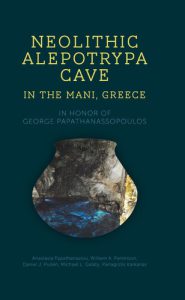Neolithic Alepotrypa Cave in the Mani Greece 1st Edition Anastasia Papathanasiou, William A Parkinson, Daniel J Pullen, Michael L Galaty, Panagiotis Karkanas 9781785706516 1785706519
$50.00 Original price was: $50.00.$25.00Current price is: $25.00.
Neolithic Alepotrypa Cave in the Mani Greece 1st Edition Anastasia Papathanasiou, William A Parkinson, Daniel J Pullen, Michael L Galaty, Panagiotis Karkanas – Ebook PDF Instant Download/Delivery ISBN(s): 9781785706516, 1785706519

Product details:
- ISBN 10: 1785706519
- ISBN 13: 9781785706516
- Author: Anastasia Papathanasiou, William A Parkinson, Daniel J Pullen, Michael L Galaty, Panagiotis Karkanas
Alepotrypa Cave at Diros Bay, Lakonia, Greece, is a massive karstic formation of consecutive chambers ending at a lake. The cave was excavated by G. Papathanassopoulos from 1970 to 2006. In conjunction with the surrounding area, it was used as a complementary habitation area, burial site, and place for ceremonial activity during the Neolithic c 6000 to 3200 BC. As a sealed, single-component, archaeological site, the Neolithic settlement complex of Alepotrypa Cave is one of the richest sites in Greece and Europe in terms of number of artifacts, preservation of biological materials, volume of undisturbed deposits, and horizontal exposure of archaeological surfaces of past human activity and this publication is an important contribution to ongoing archaeological research of the Neolithic Age in Greece in particular, but also in Anatolia, the Balkans and Europe in general. This edited volume offers a full scholarly interdisciplinary study and interpretation of the results of approximately 40 years of excavation and analysis. It includes numerous chemical analyses and a much needed long series of radiocarbon dates, the corresponding microstratigraphic, stratigraphic and ceramic sequence, the human burials, stone and bone tools, faunal and floral remains, isotopic analyses, specific locations of human activities and ceremonies inside the cave, as well as a site description and the history of the excavation conducted by G. Papathanasopoulos.
Table contents:
1. Introduction: Anastasia Papathanasiou
2. Alepotrypa Cave: the site description and its cultural and chronological range: Anastasia Papatha
3. Stratigraphy and site formation processes of Alepotrypa Cave: Panagiotis Karkanas
4. The stratigraphic and pottery sequence of Trench B1 at Alepotrypa Cave: a first approach to the i
5. When do the dead become dead? Mortuary projects from Ossuaries I and II, Alepotrypa Cave: Stella
6. Patterns of pottery consumption, destruction and deposition at Alepotrypa Cave: the case of Chamb
7. Pithoi with relief decoration from Alepotrypa Cave: George Valvis
8. The Alepotrypa Cave pottery assemblage: a ceramic petrology approach: Areti Pentedeka
9. The chipped stone industries of Alepotrypa Cave: a general presentation: Georgia Kourtessi-Philip
10. Macrolithics: ordinary things in an extraordinary place: Anna Stroulia
11. Patterns of exploitation and exchange: preliminary compositional results of the obsidian assembl
12. Neolithic bone and antler artefacts from Alepotrypa Cave: Georgia Stratouli
13. The people of Alepotrypa: Anastasia Papathanasiou
14. The macrofaunal assemblage of Alepotrypa Cave: Angelos Hadjikoumis
15. Radiogenic strontium isotope results from the burials of Alepotrypa Cave: Julia I. Giblin
16. The plant remains from Alepotrypa Cave: use, discard and structured deposition: Evi Margaritis
17. The exploitation of marine animal resources at Alepotrypa Cave: harvesting strategies, managemen
18. Phytolith analysis from the sediments of Alepotrypa Cave: Georgia Tsartsidou
19. Wood charcoal analysis from the sediments of Alepotrypa Cave: Maria Ntinou
20. The microfauna from Alepotrypa Cave: Katerina Papayianni and Thomas Cucchi
21. Speleothems from Alepotrypa Cave: towards climate reconstruction: Meighan Boyd and Kathrin Holmg
22. The Diros Project, 2011–2013: surface survey and site collection in Diros Bay: Daniel J. Pulle
23. An integrated assessment of Alepotrypa Cave: Anastasia Papathanasiou
People also search:
alepotrypa cave map
mani caves greece
neapolis ancient greece
a neolithic farming village is called
a neolithic town in central turkey
You may also like…
Uncategorized
Politics & Philosophy - Anthropology
Politics & Philosophy - Anthropology
Uncategorized
History - Ancient History
Religion & Spirituality - Christianity
The Christian Theological Tradition 4th Edition Mark Mcinroy Editor Michael J Hollerich Editor
Medicine - Oncology












